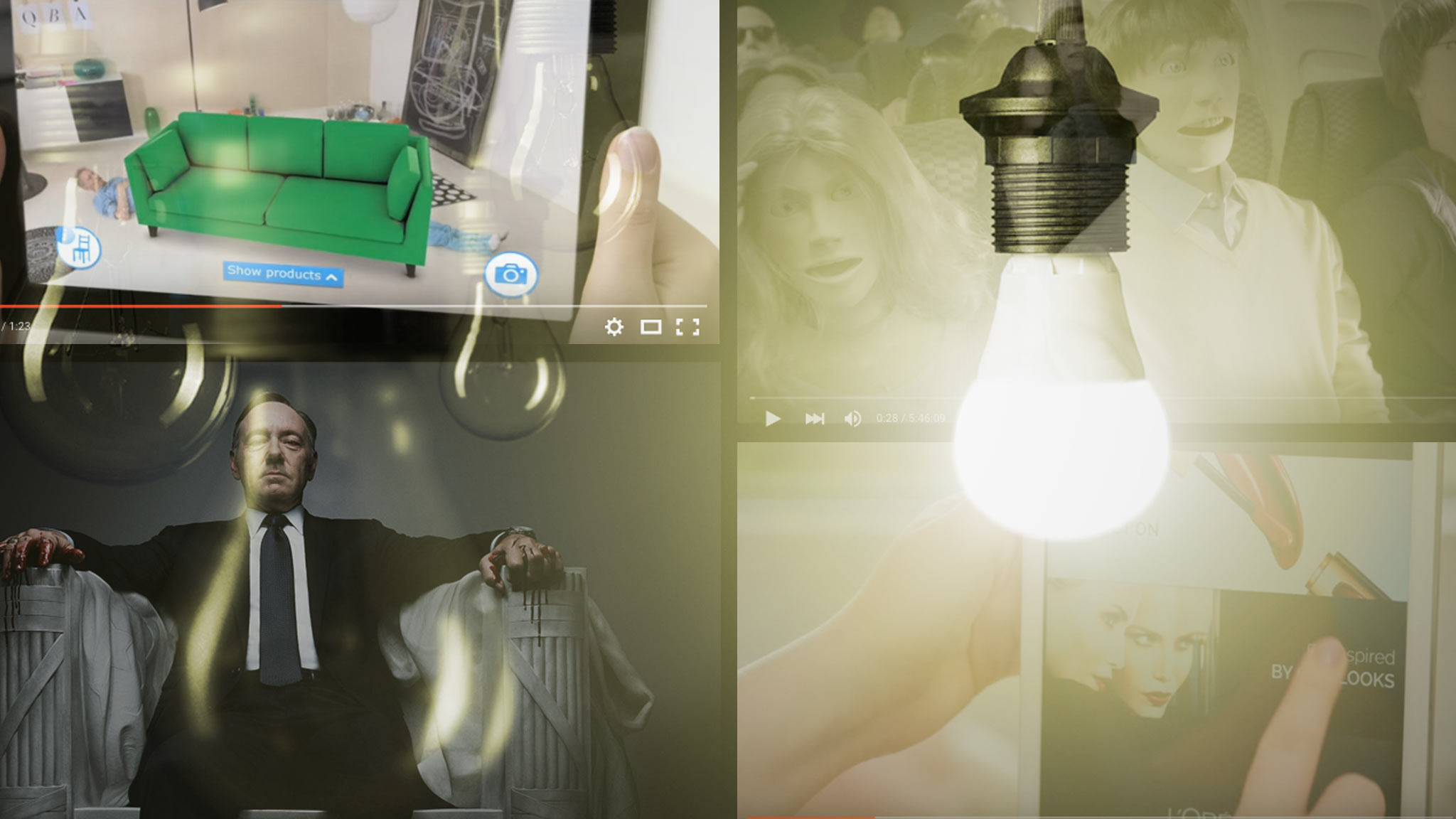Retail marketing strategies have been evolving in the direction of omni-channel marketing over the last few years, as seamless brand reach and interaction across TV, catalog, Internet (mobile and desktop) and brick-and-mortar stores is the Mecca top brands are striving for.
In 2014, ecommerce and in-store retail came together in innovative ways. Technology enhanced in-store shopping experiences with augmented reality. Real-life customers were embraced as brands’ hot new models. And brands handed over control, trusting influencers to present products in fresh and creative new ways.
Here’s a look back at the retail marketing strategies big brands adopted in 2014 to enhance the shopping experience, seamlessly transitioning online and offline.
1. IKEA Catalog Virtually Beams Furniture Into Consumers Homes
Sure, that ottoman looks great in the perfectly staged pages of a catalog, but how would it look in your living room? IKEA’s augmented reality catalog answered that question, with an app that could beam the likes of the furniture company’s products into an image of a consumer’s own space.
When IKEA’s 2014 furniture and home goods catalog was paired with a downloadable mobile app, viewers got a realistic visualization of how those products could fit into their actual life. Because the app got 8.5 million downloads following its December 2013 launch, IKEA products are now a tap away from purchase in the pockets of millions more consumers.
Bryan Eisenberg, author and founder of IdealSpot, says there’s so many things that were done well in the IKEA campaign. “IKEA has brilliantly executed this omni-channel campaign,” he said.
While allowing consumers to visualize the products in their home is good, Eisenberg says what makes the campaign excellent is “how great of a job they do at making customers anticipate the arrival of the physical IKEA catalog.”
“Go ahead and think back to the last time you were anticipating promotional mail,” Eisenberg said. “IKEA is letting customers know about all the fun you can have with the catalog, even if you don’t go to the store. The cherry on top of this deliciously executed ad is the message that the catalog, just like going to an IKEA store, isn’t just about picking up products, it is all part of the fun, interactive brand experience IKEA has created.”
Chris Boggs, founder of WebTrafficAdvisors.com, says the IKEA campaign was among his favorites from this list, and that “its usefulness and appeal is obvious,” saying that “this type of app also acts in a broader capacity to help marketing as a whole evolve to providing better and better virtual technology for consumers to use during product consideration.”
Analyzing the campaign from a consumer perspective, Boggs said that if he were in the market for new furniture, “I would definitely consider this app for use with my iPad. Personally, the larger the screen, the better for me, although the images I hope could be transferred from a smaller handheld device to a larger one, or for me to view on a laptop, or to share with others via text or email. My likely preference would be to use Chromecast or Apple TV to be able to wirelessly view on a large screen.”
And as a consumer, Boggs said the “family imagery in the promotional video resonated with me, as I could see my kids and I acting in the silly manner portrayed. However, I felt a few more ‘real’ images of how this app would render the proposed furniture piece into a more crowded (realistic) room without all the jumping around would have been useful. In a marketing sense, I guess this was effective, as it left me wanting a little more.”
What might Boggs have done differently with the campaign, given the chance?
“The whole app theme and subject should be covered by IKEA with SEO and PPC. A search for ‘ikea augmented reality’ results in a failing grade from my perspective for IKEA, because their own domain isn’t represented until the fourth organic result.”
“There is also no paid listing supporting the app,” he added. “Granted, the iTunes and Google Play links directly to the app are prominent, but the two media sites currently ranking prove that most of the downloads came from buzz. IKEA could do some relatively simple SEO to get their page to No. 1, and the iTunes and Google Play downloads above the media as well.”
Retail marketing strategy takeaways:
- IKEA is using cutting edge technology to help shoppers picture what their life would be like with their products. How can you remove the unknown, and help customers see exactly how much better things could be with your products?
- What retailer doesn’t want their products in their customers’ pockets? Making an online brand presence mobile friendly was a hot topic of marketing in 2014. Whether it’s a mobile app, a mobile site, or a mobile-responsive design, retailers must take care to ensure their customers have optimal interactions on their phone.
2. Target Turns To Top Vine Users to Showcase Products
Traditional advertising was all about controlling the message; new media marketing rewards brands that give up control and let customers and fans carry the message. With the help of social video collective Unpopular Now, big box retailer Target trusted that its products would shine in innovative short-form video produced by invited Vine users.
In April, Target sent 10 Vine artists a mystery box of props and asked them to film and post to Vine one video of them opening the box and a second video of them using the items inside the box. Videos and the campaign were hashtagged #unPOPthebox.
While Target started the campaign with 10 carefully selected Vine users, the brand was flexible and open to letting it evolve. Social media gave the campaign a life of its own, with increased reach as a result. #unPOPthebox was the 2014 Mashies award winner for Best Use of Vine.
Vine artist yelldesign created this Vine from his Target gift box:
Retail marketing strategy takeaways:
- Step one in this campaign was Target tapping into online influencers in return for free products; the Target brand was shared with influencers’ networks. If there’s an influencer that matches your customer persona, could your great customer service get back to their networks?
- While Target gave its products away, the brand was paid back with free user-generated content. User-generated content can be a golden asset online, providing social proof that a brand can’t manufacture for itself.
- By focusing on the emerging social network Vine, Target could stand out in one of the less-saturated social spaces. New social platforms and communities just beginning to gain traction could be opportunities for early adopter brands.
3. Brands Vote: America’s Next Top Model Is You
Retail marketing trend alert: more and more brands are using social media to prominently feature their own customers wearing and using their products. Brands have long brought attention to celebrities donning their goods. But with social media, every consumer is an opportunity for product placement.
“People trust complete strangers more than they trust brands,” according to Jose de Cabo, co-founder of Olapic, a software applications that helps retailers search social media for photos and post them on websites. “People who click on real-people photos are two times more likely to convert to a sale.”
In April, Marc Jacobs brought the customers-as-models trend to the next level with an open casting call for the next face of the brand. All that people had to do was post a picture of themselves on Instagram or Twitter with the hashtag #CastMeMark to enter.
Retail marketing strategy takeaways:
- When user content is re-shared by major brands, it encourages more content and participation. The brand gets more content and ever-broader exposure.
- By reposting user-generated content on a brand site and photo galleries, the original posters feel a connection with the brand, helping to build loyalty. Campaigns like 2013’s #CoachFromAbove capitalize on everyone’s desire for 15 minutes of fame. That brand has gained that customer’s loyalty and a life-long positive association.
What other new or noteworthy retail marketing strategies did you notice in 2014?


